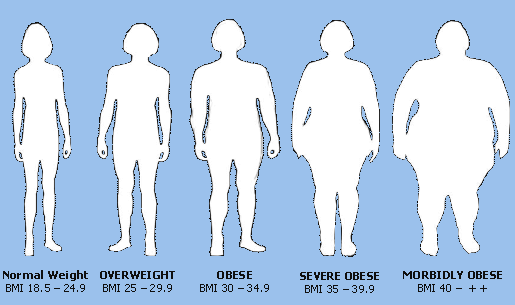| |
 When
an overweight or obese person presents with a sign or symptom of a
disease in clinical practice, the clinician needs to always consider
the following questions: When
an overweight or obese person presents with a sign or symptom of a
disease in clinical practice, the clinician needs to always consider
the following questions:
1) Is the presenting condition causally related to excess weight?
2) Is the presenting condition merely aggravated by excess weight?
3) Is the presenting condition unrelated to excess weight?
If the presenting condition is largely caused by excess weight (e.g.
sleep apnea, type 2 diabetes, hypertension, gastroesophageal reflux
disease, etc.) then there is a good chance that weight loss will
reverse or “cure” this condition.
If, on the other hand, the condition is not caused by obesity but is
merely aggravated by excess weight (e.g. COPD, congestive heart
failure, urinary incontinence, etc.), then, although weight loss may
not fully reverse this condition, it could very well reduce symptoms
and make the condition more manageable.
In contrast, if the condition is unrelated to excess weight
(e.g. a flu infection, migraine headaches,
infectious hepatitis, etc.), then losing weight is unlikely
to have any effect on this condition at all. Accordingly, in the
first case, if excess weight is indeed the causal factor, then not
addressing obesity can only be considered “palliative care”
(as in primarily managing an overweight Type 2 diabetic patient with
hypoglycemic drugs or merely placing an overweight patient with
obstructive sleep apnea on CPAP). In other words, symptomatic
treatment without also targeting excess weight is unlikely to fully
resolve the problem. These patients would have a primary indication
for weight management – anything else is a “band-aid” solution.

When dealing with conditions not causally related to obesity, but
where excess weight is a significant aggravating factor, the primary
focus should of course be on treating the underlying condition. Only
if this is not possible, will weight loss be an option to at least
ameliorate the condition – this would be a secondary indication for
weight management.
Obviously, for conditions presenting in overweight and obese
patients that are unrelated to excess weight, weight loss is
unlikely to have any impact on the problem. Thus, the focus should
be on treating the underlying problem, which when solved, will still
leave enough time to address the excess weight issue – if clinically
indicated. These patients would have a tertiary indication for
weight management.
Indeed, it is in cases 2 and 3 where mistakes are most often made;
automatically assuming that all problems in overweight or obese
patients must be a consequence of their excess weight can lead to
delay of proper diagnostic procedures and treatments.
Thus, for example, assuming that the back pain in an obese patient
is likely weight related can delay the diagnosis of osteoporotic
fractures, spinal disc syndromes or even identification of
metastasis. Similarly, simply assuming that exertional dyspnea in an
obese patient is a consequence of excess weight may result in
missing underlying interstitial, infectious or embolic disease.
It is therefore crucial that before jumping to the conclusion that
excess weight is the primary problem for all symptoms and problems
in overweight and obese patients, clinicians should maintain due
diligence in terms of history, physical examination and diagnostic
testing before simply recommending weight loss. This is not to say
that these patients may not also benefit from weight management, but
it certainly should not be the first priority before addressing the
presenting complaint or condition.
Indeed, nothing frustrates overweight and
obese patients more, than when every sym
ptom or complaint is automatically blamed on their excess weight
leading to the useless advise to simply “eat less and move more”.
|
![]()